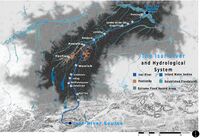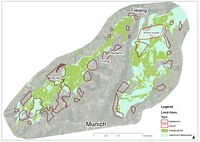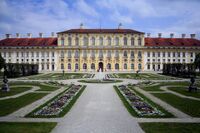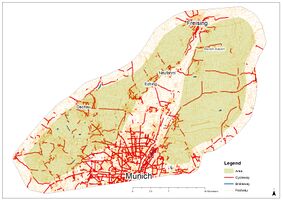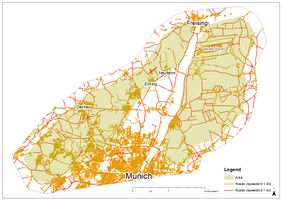WAVE Team 2 Freising 2021
>>>back to working groups overview
| Area | Bavaria | |
| Place | Dachau | |
| Country | Germany | |
| Topics | Peatland restoration | |
| Author(s) | Marie-Luise Dexl and Luke Miller | |

| ||
Rationale
Peatlands in general are an important living space for humans and nature. Also the peatlands near Freising have a high importance for the population in a cultural and an ecological sense, which means it is delivering important ecosystem services. A possible challenge, this landscape is facing is the land-use change which happened in the past and is still happening.
Location and scope
You can edit this map with the map editor
Water as a natural system
Geomorphology, typologies and dynamics of water areas
Besides precipitation as an obvious source of water in the Isar river basin, the water system has numerous vital sources: Perhaps the most significant water source is the substantial ground water table which flows from the south to the north.
In addition, the water system is supplied by Glacier & Snowmelt which melts after the winter snow fall periods and feeds the Isar River and other water bodies in the system, during the spring season. This dramatically increases the water table.
Historically, the landscape around Freising, Munich and Dachau have traces of non-functioning canal systems. However there are still canal networks that are flowing and in use. Although some of these canals have degraded and no longer perform their initial functions of directing and channelling water, they have a high cultural and heritage value to the landscape.
Furthermore, the region is scattered with lakes, dams and gravel excavation pits that have been converted into recreational swimming lakes (Pullinger Lake near Freising). Additionally, the Ismaninger Speichersee is situated close to the city of Dachau, while the south of the region is scattered with beautiful mountain lakes (Tegernsee, Walchensee and Starnbergersee).
The landscape in this region supports an incredibly important biotope landscape: the Peatlands found in this region not only provide specific habitats to a wide variety of endemic flora and fauna, but also are regarded as a powerful alley in the fight against climate change for the function as a substantial storage of greenhouse gases.
Water as a living space
In former times, the peatlands have been a habitat for special plant and animal species, like birds, insects, or amphibians. Nowadays it is cut by settlements, roads, and the Munich Airport, some parts are used for agriculture. Just patches of natural habitats have survived, like the ‘Streu- und Feuchtwiesen’ or the ‘lichten Moorwälder’ in the areas of the Verein Dachauer Moos e.V. Here, highly protected plant species, like Iris sibirica (lily) or Scorpidium (moss) can be found, which makes these habitats really special. Even in ditches and streams special Flora and Fauna can be found. Some of these areas part of the NATURA2000 Programme and therefore protected by European law. Furthermore, a lot of lakes and rivers can be found here, some with special flora and fauna as well.
The water quality of this area is depending on the quality of the groundwater. Some areas are drinking water areas with sufficient water quality to use it for human consumption. In other parts, intensive agricultural or urban land-use is lowering the water quality.
Blue and Green Infrastructure
The map clearly shows a very fragmented green infrastructure, for example just small forest patches exist in the area. Special forest types can evolve on peatland as well, like 'lichter Moorwald', mostly formed by birches. A mayor element found is agricultural used land, which evokes a conflict with peatland soils (draining of peatland etc.). The blue infrastructure is good connected, with the Isar river and the 'Ismaninger Speichersee' as main elements. It is very likely, that green and blue infrastructure will change and espacially green infrastructure vanish in the future, because of the settlement pressure from the surrounding regions.
Water as a cultural space
Land use and water
In an early stage, especially the Dachauer Moos, was a waste Landscape, home of murderers and thieves, who got no where else to go.
Later, more and more people came to the peatlands to cultivate them and use it for peat extraction (e.g. used as heat material) and agriculture. Therefore, the peatland was drained, which also changed the soil characteristics, leading to Greenhouse gas emissions from the soil. In this time more and more painters came to the peatlands, to paint the beautiful landscape. Meanwhile, the urbanization of the landscape was intensified.
Today, this landscape is highly urbanized and in agricultural use with small patches of natural areas.
It is very likely that the human use of the landscape is intensified, because of driving forces like the need of living space or agricultural land for humans. Drivers in the opposite direction are the identification with the peatlands as a ‘Home landscape’ and need of the population for recreation.
Draining the landsdcape, and therefore intensifiing the land-use has an impact on the storage of carbon in the peatland soil. When draining peat, the carbon is released in a form of greenhouse gas emissions and is distributing significantly to climate change. The process is explained here in a simple way: While the upbuilding of the peatlands, plants use CO2 for photosynthesis. In this process, the plants store the CO2 as organic matter and die. Due to the high water table, this organic material is decomposed slower than its build up and can be stored. If the proportion of organic substance exceeds 30%, it is called peat. If this peat is drained, the organic matter is decomposed faster than it is build up and the carbon is released as greenhouse gases, e.g., CO2.
Cultural and spatial typologies of water areas
The area is mostly influenced by its agricultural use (draining of peatland area), as well as settlements and the munich airport, as seen in the map. The initial peatland area was reduced and fragmented by these land-use change processes,this is still going on. It is possible to say, the the use-patterns which evolved are mostly agriculture and settling. The remaining part is important for waterextraction and other ecosystem services, as explained before, so the use-patterns can be called extracting of goods for human health. Here, other evolved use-patterns, in connection to the identity of the landscape is the recreation and experiencing the landscape.
Sacred spaces and heritage
Most places, which are important in a cultural way have been build with a religious purpose, for example Churches or chapels. The importance arised in the past, where religion was very important for the people. Other important places like the water tower or certain castles are important as a landmark or their history, which is connected with the there living people. Especially important is the Canalsystem of the Neues Schloss Schleißheim as well as the castle itself. Both are important landmarks with a lot of history. Aditionally, both monuments are very famous and protected after national law.
Visual appearance and landscape narrative
The peatlands and especially the Dachauer Moos were and are important recreation areas near munich. Here the people can flee from the overall urban cities into a more or less still waste and natural landscape. This is very important for most of the people living in big cities. This use for recreation was especially aprreciated by famous painters in the past. They came there to paint the beautiful and idyllic landscape. Often its wildness is stressed, so one essential element, still today, are the natural areas. But nowadays, historical elements shape the landscape as well, like the 'Schleißheimer canalsystem' or the 'Neues Schloss Schleißheim'. Agricultural areas are also an important elemnt that shaped and still shapes the landscape. The rural sides were also painted by painters and are today visited by the normal population. But the ways of agricultural use changed and more areas are intensified, changing the special character of the landscape and turning it into a homogenic and generic landscape, which is often found in germany. It is possible to say, that the peatlands amazed people back then as well as today. This gives them an important role for the identification of the people with their landscape and therefore with their home.
Water and People
Accessibility and usability
It is possible to enter the landscape everywhere, it is accessible by roads and paths for cars, bikes and by foot. Most of the areas are used by farmers to produce agricultural products, some are also keeping animals like cows or horses. The more natural areas are used by the surrounding population for recreation by taking walks, walking your dog or swimming in lakes. Some people are protecting and renaturing areas, they use it as a identification with their living spaces. There are different uses of the peatland around freising. The natural areas have a recreational potential for walking or relaxing, taking a break from the urban spaces for the surounding population. Cycling and riding tracks as well as the water areas can be used for sportive activities and the monuments show a potential for a touristic even educational use. These monuments can also be used to enhance the identical connection of landscape and people, like the whole peatland area.
Community Mapping
What is to be mapped here?
- Social groups from within the community, for example the youth, kids, students, parents, the retired etc. Typically, these groups have specific needs, which you can also make explicit on the map. These people might not be organized in any way, but they are usually present in the context you are observing
- Local stakeholder groups: these groups are organized in one or the other way. They only exist within the community context you are observing. For example: the local community center, local churches, local interest groups, the landowners, small businesses and retailers
- External stakeholder groups are not necessarily present in the environment you are observing, but they may have strong stakes and interests. These can be local authorities, politicians, associations, care services etc.
- For each group, you may identify their needs, objectives, power and capacities
- You may also identify gaps and power conflicts
- Please try to redepict these elements in an integrated way and in relation to your water landscape. What is the relationship between these groups? Are they close or distanced from each other? Who is more powerful? Which voices are hardly heard? Do they have any shared concerns?
- Your case your community map1.jpg
add a caption
- Your case your community map2.jpg
add a caption
- Your case your community map3.jpg
add a caption
Possible Futures
In our systems analysis of the Peatlandscape we have identified 4 main Sustainability goals that are at risk: (12)Responsible Consumption and Production - as agriculture is in sharp contrast with these peatlands, it is paramount that sustainable agricultural methods be used in harmony with peatlands (13)As Peatlands are indispensable against the fight against climate change, as an essential carbon store habitat and they have been drained in many parts of our focus area (14)Peatlands are comprised of important habitats for aquatic species that are jeopardized when peatlands are destroyed (15)A peatland is a landscape that encompasses the realms of both water and landscapes and is there an important landscape to protect
The worst-case scenario: Neglected and Urbanized describes a landscape that has been entirely exploited where peatlands no longer exist. The concrete cubes represent the urban landscape that continues unabated, further fragmenting and utilizing the landuse. The maize crops represent conventional agricultural practices where peatlands are drained for the use of conventional agriculture.
The best-case scenario Protected and Naturalised is a landscape where humans farm in harmony with peatlands, where science is used to continue the careful monitoring of peatlands and the ultimate protection of their existence - by maintaining the water table within the landscape
Collaborative Goal Setting
- Define strategic planning objectives based on the evaluation findings from your analysis
- Ideally, involve the community of your living labs into this process
- Link back to your original targets from section one and the Development Goals
- 150 words text contribution
Spatial Strategy and Transect
- translate your strategic goals into a vision
- develop a spatial translation of your vision
- exemplify your vision in the form of a transect with concrete interventions
- add map(s) and visualizations
- Your case spatial translaton vision.jpg
add caption here
- Your case transect.jpg
add caption here
- Your case transect detail1.jpg
add caption here
- Your case transect detail2.jpg
add caption here
From Theory of Change to Implementation
- For implementing your vision: Which partnerships are needed? Which governance model is required?
- Who needs to act and how? Draw and explain a change/process model/timeline
- Which resources are needed? On which assets can you build?
- add 150 words text and visuals
References
- give a full list of the references you have used for your case
Process Reflection
- Reflect in your intercultural and interdisciplinary team on the outcomes of your study
- Which limitations were you facing?
- What have you learnt from each other?
- What did you learn in the Living Labs?
- What would you do differently next time?
- You can also use diagrams/visuals
- 250 words text
